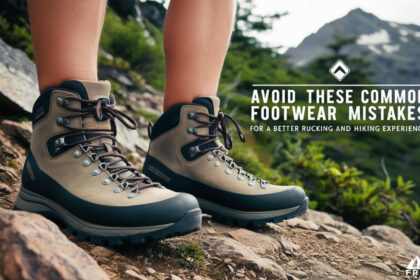
Key footwear mistakes to avoid for a comfortable and safe rucking and hiking experience.
Understanding the Importance of Proper Footwear for Rucking and Hiking
Rucking and hiking are increasingly popular outdoor activities that combine physical fitness with the enjoyment of nature. Rucking involves walking with a weighted backpack, while hiking typically refers to walking in natural environments, often on trails. Choosing the right footwear is crucial for both activities as it significantly enhances comfort, performance, and safety. Proper footwear can improve stability on uneven terrains, which is essential to reduce the risk of injuries or falls, especially when navigating rocky paths or steep inclines.
Selecting the right shoes contributes to the overall enjoyment and success of outdoor experiences. For instance, hikers equipped with appropriate footwear are more likely to complete longer trails without discomfort, encouraging them to explore more frequently. A well-fitted and suitable shoe can make a significant difference in how one feels during and after a hike or ruck, thereby fostering a more positive relationship with outdoor activities.
Importance of Proper Fit and Sizing
Properly fitting footwear is vital to prevent long-term foot issues such as blisters, calluses, and other painful conditions. It is advisable to measure both feet, as many people have one foot larger than the other. Shoes should accommodate the larger foot for an optimal fit. When trying on shoes, the longest toe should ideally be a thumb’s width from the shoe’s end, allowing enough room for toe wiggle. This is particularly important when considering that foot size can change due to factors like age or weight, meaning past sizes may no longer apply when selecting new footwear.
Footwear should feel comfortable right from the start; any discomfort can worsen over time. For example, if a shoe pinches the sides of the foot during a short walk, it is likely to cause significant pain on a long hike. Additionally, trying shoes on at the end of the day is recommended, as feet tend to swell, ensuring a more accurate fit that matches your size during extended wear.
Common Footwear Mistakes
Many hikers and ruckers make common footwear mistakes that can lead to discomfort and injury. One prevalent error is wearing new shoes on long hikes without breaking them in first. This can result in blisters and significant foot pain. It’s always advisable to wear new shoes on shorter walks before tackling longer distances. Another mistake is selecting the wrong type of footwear for specific terrains. For instance, using lightweight trail runners on rugged or muddy trails where hiking boots are more appropriate can lead to instability and discomfort.
Ignoring the need for proper ankle support is another common oversight. High-cut boots are ideal for carrying heavy packs across uneven terrains, providing necessary support to prevent ankle injuries. Moreover, neglecting the importance of adequate cushioning can lead to foot fatigue, especially over long distances. Worn-out shoes should also be replaced regularly, as they can lose traction and support, increasing the risk of slips and falls. Finally, failing to consider weather conditions when selecting footwear can lead to inadequate protection, resulting in cold, wet, or overheated feet.
Terrain-Specific Footwear Choices
Choosing the right footwear for different terrains is essential to enhance performance and safety. High-cut boots provide excellent ankle support and are well-suited for heavy packs, making them ideal for rucking with loads over 40 lbs. However, they can overheat in warm conditions. Low-cut boots, while lighter and providing more breathability, are better suited for dry trails and short distances but offer less ankle support.
Trail running shoes are another option; they are lightweight and designed to minimize blister risk yet lack the durability needed for heavy loads. Approach shoes, which are versatile for both hiking and climbing, offer grip but may not be waterproof, making them less suitable in wet conditions. Hiking sandals can be appropriate for casual hikes in warm climates but leave feet exposed to potential injuries. Cross trainers serve as a budget-friendly option for light trails but may not provide the specialized support needed for more rigorous hikes.
Breaking In New Footwear
Breaking in new footwear is a crucial step before embarking on long hikes or rucks. It is recommended to gradually increase the duration of wear for new shoes to prevent discomfort. Wearing appropriate socks and considering orthotics can also help achieve a better fit. Testing new footwear by walking and using stairs in-store is essential to assess comfort and fit before making a purchase.
Starting with shorter, less demanding hikes allows your feet to adjust to the new shoes, reducing the likelihood of issues on longer trips. Paying attention to any pressure points or discomfort during the break-in period can help identify potential problems early, leading to a more enjoyable experience. Using shoe trees or stuffing shoes with newspaper can help maintain their shape while breaking them in.
Foot Care Tips for Rucking and Hiking
Proper foot care is essential for anyone engaging in rucking and hiking to prevent injuries and discomfort. Keeping feet dry is crucial, and using moisture-wicking socks can significantly reduce the risk of blisters. Applying blister prevention products or taping vulnerable areas before hikes can also be beneficial. Regularly inspecting feet for signs of irritation or blisters after long distances is a good practice to catch any problems early on.
Hydration plays a vital role in maintaining skin elasticity and reducing the risk of blisters, so keeping the body well-hydrated is key. Moreover, trimming toenails before hikes can prevent them from hitting the front of the shoes, which can cause pain and discomfort. Using foot powder or antiperspirant can also help keep feet dry and minimize friction during prolonged activities.
Best Practices for Selecting Footwear for Rucking and Hiking
When selecting footwear for rucking and hiking, it’s essential to research and read reviews to find the best fit for your personal needs and preferences. Consulting with experts at outdoor gear stores can provide tailored recommendations based on your specific activities and foot shape. Experimenting with different brands is advised, as sizing and fit can vary significantly between manufacturers.
Consider the weight of the footwear; lighter options enhance comfort during long hikes but may sacrifice support. Additionally, assess the tread pattern of the soles; deeper lugs provide better traction on slippery or uneven surfaces. Evaluate waterproofing features if you anticipate wet conditions, with Gore-Tex being a popular choice for breathable waterproofing. Taking these factors into account will help ensure you select the right footwear for your outdoor adventures.



